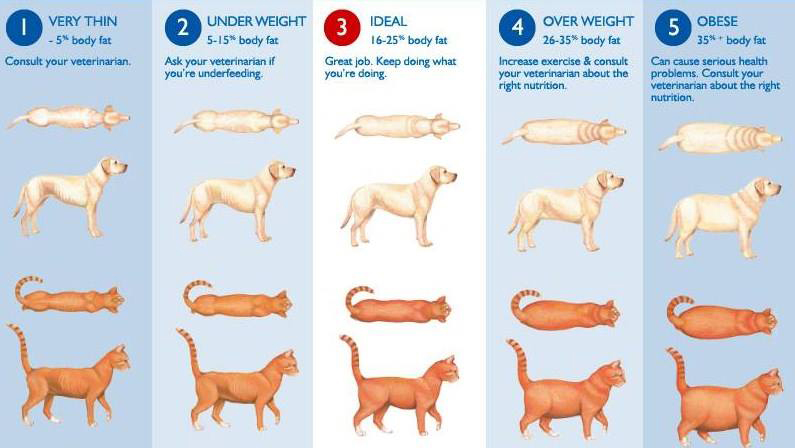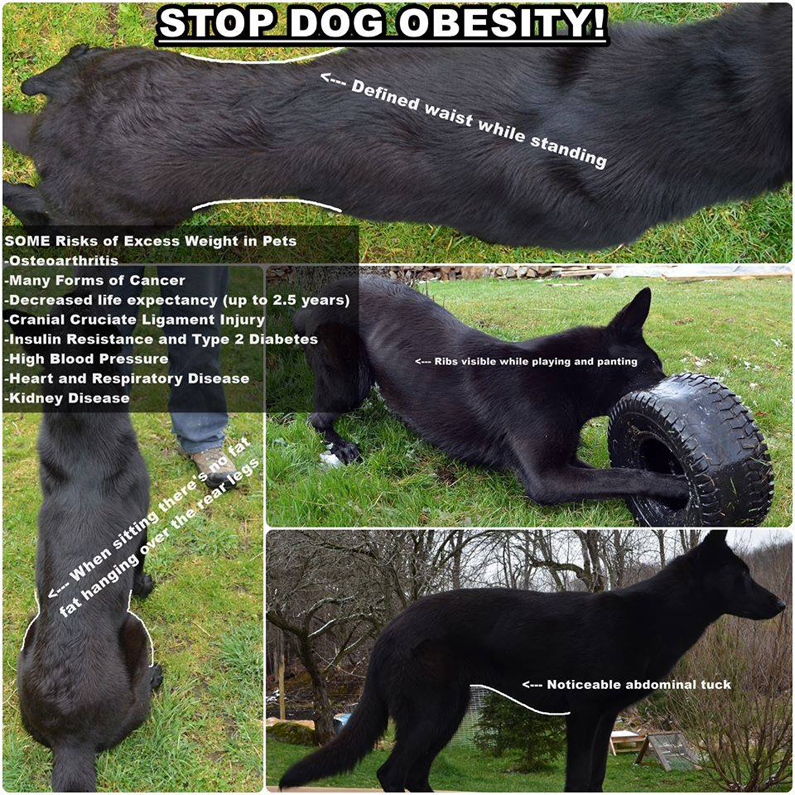Pet obesity is a major problem in the US these days. The latest statistics from the American Veterinary Medical Association indicates that nearly 70% of our pets are overweight, and 60% are obese. The term “obese” indicates the individual is at least 20% over their ideal weight. That means that a normally 80 pound German Shepherd could be carrying more than 16 pounds of fat. That’s an incredible burden on a musculoskeletal system that was designed to support a slender working dog. Aside from the obvious problem of the bones and joints supporting the excess weight, an overweight dog has more of a problem dispersing body heat in the summer from not only the insulating effects of the fat, but panting requires more energy to move a heavier chest wall. Fat accumulates within the body as well as around the outside. The heart and kidneys become surrounded with fatty tissue, the liver becomes infiltrated with it. Fat (or adipose tissue) does not simply sit there quietly as a storehouse for excess energy in the form of fat. It is an active tissue that secretes hormones, inflammatory proteins, and chemical and molecular messengers.

The effects of Adipose Tissue
In the past few years, researchers have identified over 100 substances produced by adipose tissue. These substances create an extensive communication network within the adipose stores and between it and other organs. Some are directly related to other diseases as well. As an example of how powerful these small proteins can be: One in particular, called leptin, promotes inflammation and oxidation, among other things. Inflammation includes all the ways the body strives to protect itself and remove abnormalities and invaders. These include changes in blood vessels, specific cellular recruitment, destructive molecules and chemicals. The result of inflammation is more inflammation until the cause is gone – always until the cause is gone. Oxidation is essentially degeneration and aging at the cellular level. That’s overly simplified, but I’m sure no one wants a chemistry discussion here. (If you do, call me, it’s fascinating stuff!)
Be sure to eat those antioxidant fruits and veggies to improve your own body! If the body continues to add adipose tissue, the amount of leptin released increases further. Before long, the signal that the body is satisfied, from a hunger standpoint, is deactivated by this protein. This results in more calories consumed, more adipose tissue accumulated, and more leptin made and released. Owners with obese animals feel sorry for them because “they are always hungry” so they give treats, potentiating the problem. They are hungry because of this nasty little leptin protein. More leptin promotes more inflammation, cellular aging is accelerated, and obesity-linked disorders begin to arise.
Obese Dogs
Many obese dogs are diabetic or have heart disease. Many obese horses are laminitic or have insulin resistance. Obese cats have more urinary tract diseases, and problems in the mouth. The good news is that as the body condition score decreases and weight is lost, the amount of leptin (and other such proteins) also decreases, and these diseases can begin to resolve if they are not advanced. Some of the other proteins produced by adipose tissue directly cause inflammation, and in doing so, signal the release of other molecules which serve the same purpose. Since inflammation continues until the cause is gone, and adipose tissue constantly recruits inflammatory mediators, you can appreciate that obesity itself is a constant source of mild inflammation. Again though, if that forty pound Sheltie drops a few pounds, the amount of these proteins in the blood will decrease accordingly. When the dog/horse/cat approaches normal standards for its body weight, all of this abnormal chemistry is resolved. Happier, healthier animal!

Obese Cats
Obese cats are everywhere also. Many people have house cats that do not get the normal exercise that a cat in its natural outdoor environment would have. There are low fat cat foods on the market, and treats can be carefully selected and apportioned appropriately. We are happy to show cat owners exercises, games, and management ideas to get that cat losing weight and living a longer and healthier life.
Aquatic Therapy for Weight Management
The greatest part of weight management is simple mathematics. Burn more calories than you take in and weight will go down. Low fat dog foods are in abundance now. Exercise is a must. That doesn’t mean running at the beginning because the joints are already under the stress of extra weight. Try to force serious exercise and you’re asking for a breakdown. Swimming is one of the best and safest exercises for a fat dog. The water’s buoyancy takes the weight off the limbs while allowing enough movement to burn calories and improve cardiovascular fitness. As the dog slims down and the joints and muscles strengthen, other exercises can be added. It is extremely rewarding to help an owner return a loved pet to fitness and health. The dogs don’t know they’re exercising; it’s just a fun visit to the pool where they get to play with their person. Give aquatic therapy a try – I bet you won’t be disappointed!

Recent Comments